Affiliate disclosure: This post may contain affiliate links. Please see our Privacy Policy.
Strawberry wine is simple to make at home with minimal equipment. After you’ve canned your fill of strawberry jam, a small batch country wine is a great way to preserve strawberries for year round use.
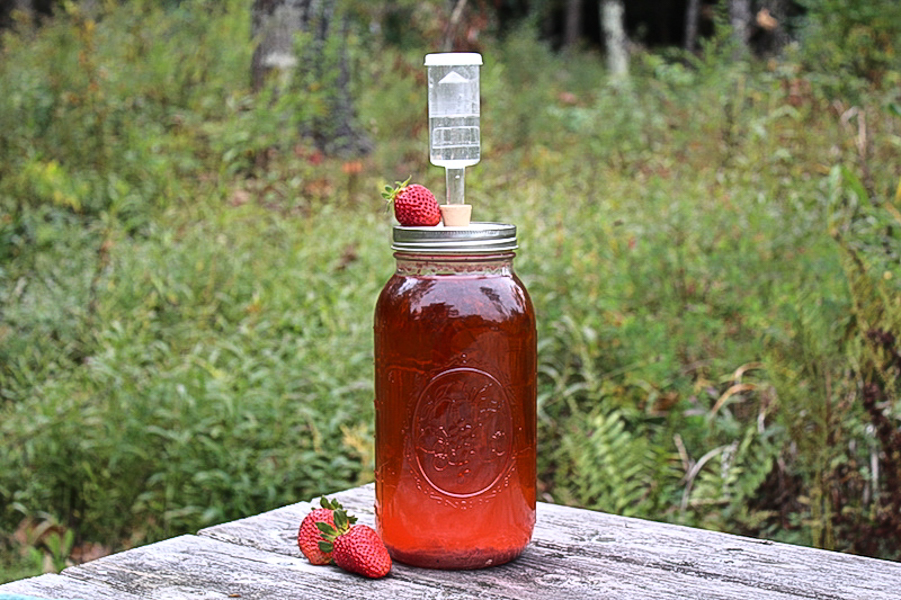
Growing up, my mom was a huge country music fan. Our local station had a pretty limited mix, and I must have heard the song “Strawberry Wine” hundreds of times in my youth. I can still hear the corus as I type,
“Like Strawberry Wine, seventeen, the hot July moon saw everything. My first taste of love, oh bittersweet, and green on the vine, like strawberry wine…”
Now that I’ve made my own strawberry wine, I can tell you that it’s in no way bittersweet and there’s nothing green on the vine about it. The song’s romantic, but a more accurate chorus would have been something along the lines of,
“Like strawberry wine, innocent and sweet. A kiss on the lips, with a taste so complete. Gentle at first, but then the flavors seep, into my heart, like strawberry wine…real strawberry wine.”
See, I’m no songwriter. I’m a winemaker, and I won’t quit my day job.
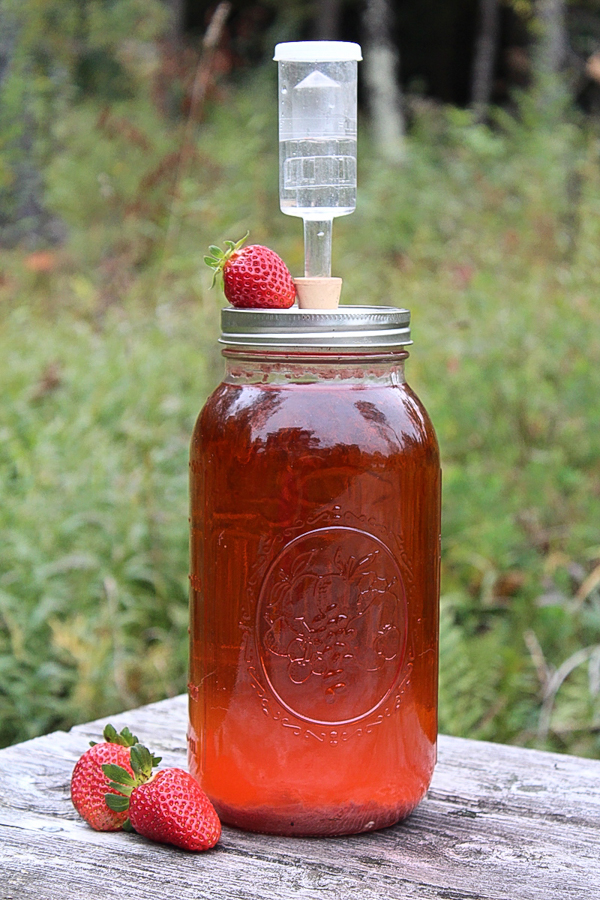
We started this batch of strawberry wine with some of the first everbearing strawberries of the year. The first spring berries are a bit on the small side as the plants wake up, but those same plants keep producing all summer. We harvest the last berries in November, and those last few are the beauties sitting right next to the mason jar fermenter above right before bottling.
I love making wine in a mason jar because it means I can just put the chunky fruit right in the jar and allow the sugar to do the juicing. Since strawberries are so soft, there’s no need to even chop them.
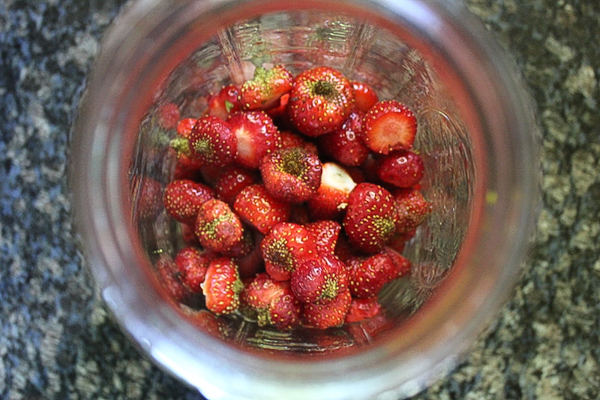
It’s going to look a bit strange, but once the strawberries are in the mason jar, just add the sugar. The sugar is going to completely cover the berries and you’ll be thinking “this can’t possibly be right…”
Wait a few hours and you’ll see. The sugar will completely dissolve the strawberries and extract their juice for the wine. Putting strawberries through a juicer just purees them, so this is a much more efficient method.
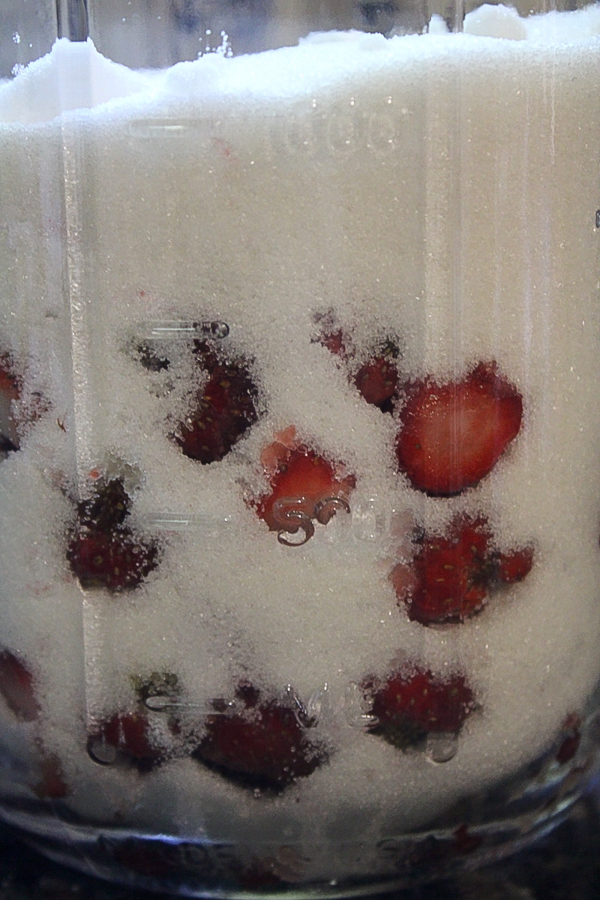
Here they are a few hours later, all the sugar dissolved and the strawberry juice extracted. Use a wooden spoon to muddle it down a bit to break up the last bits of strawberries and then you’re ready for the next step.
If you don’t have a mason jar fermenter, you can just do this juice extraction step in a bowl and then pour the whole mass into a traditional fermenter.
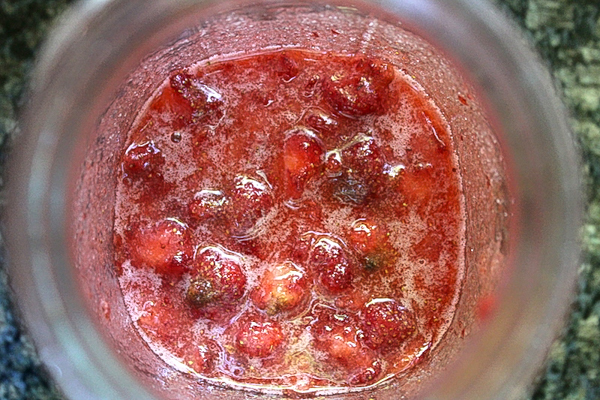
After juicing the strawberries with sugar, it’s time to add in the rest of the ingredients and a bit of water to fill the jar completely. Be sure to dissolve the yeast in a bit of water and allow it to bloom for at least 5 minutes before adding it into the strawberry wine because going straight from dehydrated to a high sugar solution can shock the yeast. Be nice, give them a minute to wake up before putting them to work.
At this point, it’s time to seal up the airlock and let the yeast do their work. Leave the strawberries in for the primary fermentation for about 2-3 weeks, and then they’ll be filtered out as you rack the strawberry wine into a secondary fermenter for another 4-6 weeks.
There are a lot of different airlocks that fit on a mason jar, most designed for making sauerkraut and vegetable ferments. There’s no reason you can’t use those same kits to make strawberry wine or any other fruit wine, mead or beer. There are a number of brands to choose from. Any of these will work.
I use a kit by Fermentools that looks a lot like a homebrew setup, and if you choose to do bigger batches later you’ll need the rubber stopper and water lock that are included in the kit.
I recently tried out these new silicone fermentation lids from Mason Tops and loved them because they’re super easy to clean. Since there’s no airlock at the top you have to watch for tiny bubbles within the fermenter to determine when the fermentation is complete, which can be a bit tricky.
I also have a wide mouth one-gallon jar equipped with a waterlock which is handy for making full one-gallon batches without worrying about cleaning out the narrow neck on a traditional fermenter.
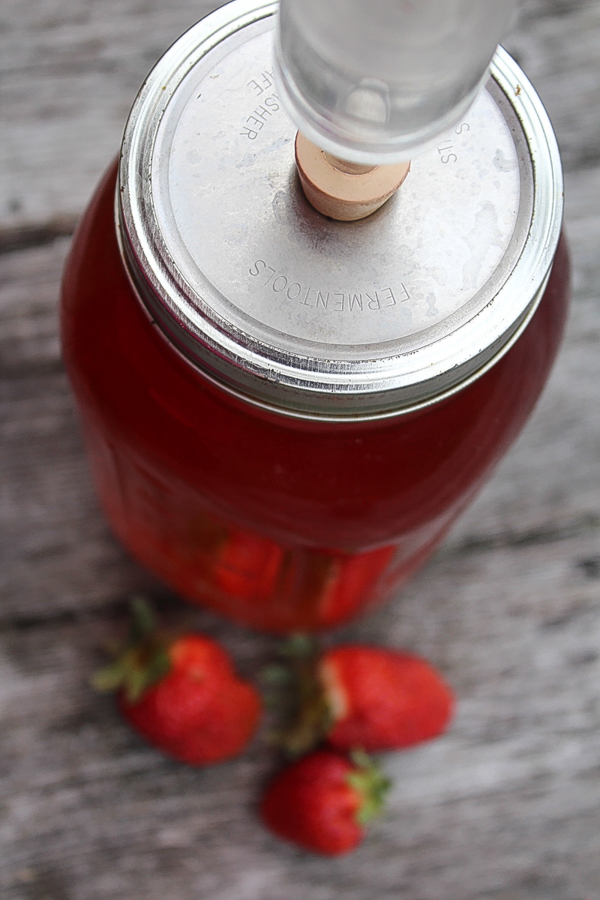
Since most people will be making a one gallon batch of strawberry wine, I’ve written this recipe for a full gallon. If you want to make a micro-batch in a quart jar, just divide by 4. Similarly, divide by 2 for a half gallon batch. Or you know, go crazy and multiply by 5 for a full five gallons of strawberry wine, and enjoy 20 bottles of tasty bliss.
For more details on the process of winemaking, read this guide to making small batch wine.
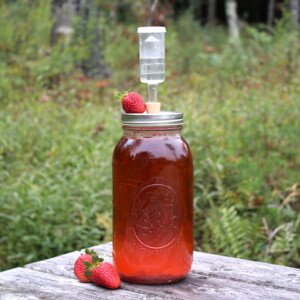
Strawberry Wine
Ingredients
- 4-5 lbs strawberries
- 2 lbs sugar
- 1 tsp acid blend
- 1 tsp yeast nutrient
- 1/8 to 1/4 tsp tannin powder
- 1/2 tsp Pectic Enzyme
- water to fill
- 1 wine yeast
Instructions
- Place the strawberries and sugar into a large bowl or directly into your fermentation vessel. Allow the sugar to pull the juice from the strawberries for a few hours.
- Add the remaining ingredients (except wine yeast) and fill with water to within a few inches of the top of the fermentation vessel. Give it a stir or shake to combine the ingredients.
- Dissolve a packet of wine yeast in about 1/4 cup of water and allow it to rehydrate for at least 5 minutes. Add the dissolved yeast into the wine base and cap the mixture with a water lock.
- Allow the mixture to ferment for about 2 weeks and then use a siphon to rack the wine into a new fermenter. Filter through a fine mesh strainer as you go to remove any strawberry chunks and leave any sediment behind.
- Cap with an airlock and allow the strawberry wine to ferment in secondary for about 6 weeks, or until fermentation is complete, before bottling.
- Bottle the wine, leaving behind the sediment. Cork bottles and allow it to age for at least a month, preferably 3-6 months before drinking.
Notes
Ingredient Substitutions
If you’d like to try to make this wine without normal pantry staples, here are a few substitutions (see the article on ingredient substitutions for more details):- 1 tsp Acid Blend = 1 TABLEspoon lemon juice
- ⅛ tsp Tannin Powder = 1 cup strongly brewed black tea
- 1 tsp Yeast Nutrient = ¼ cup golden raisins (sultanas)
- 1 tsp Pectic Enzyme = freeze the fruit for 1 week before making the wine to break down pectin
Nutrition
Nutrition information is automatically calculated, so should only be used as an approximation.
Ingredient Substitutions
If you’re hoping to make strawberry wine with just the ingredients you have on hand in your kitchen right now, there are a few easy substitutions for the winemaking additives listed above. I have a full rundown of all the substitution options in my post on Winemaking Ingredient Substitutions, but here’s a place to start:
The 1 teaspoon of acid blend can be replaced with 1 TABLEspoon of lemon juice, preferably fresh or bottled organic preservative free, as some of the bottled stuff often contains preservatives that can inhibit the yeast.
For the tannin powder, you can substitute 1 cup of strongly brewed black tea. Make a cup of black tea using a cheap tannin rich black tea (like lipton), remove the tea bag, and then pour the cooled tea into the carboy in place of some of the water.
In place of the yeast nutrient, you can add about ¼ cup of raisins. Strawberries don’t have all the right nutrients for feeding the yeast, but grapes do. For mild fruit wines like this strawberry wine, I’d suggest using golden raisins (sultanas) as they have a more neutral flavor and regular raisins will give the wine a slight molasses flavor.
The Pectic Enzyme is optional, and just helps break down natural pectins in the fruit to clarify the wine. They’ll break down on their own over time, you just might need to rack the wine into a clean carboy an extra time or two, leaving the sediment behind. Or…freezing the fruit before making the wine helps break down pectin, and it also helps extract juice. Pectin is reduced by 50% in fruit after 1 week in the freezer, so freeze it for a week before you get started. Or, you can leave your wine a bit cloudy.
The one thing that is hard to get around is the wine yeast. Don’t use bread yeast, it makes wine taste like bread, and dies out when the alcohol level is only at around 2-3%. That’s not high enough to preserve the wine. You really do need some kind of wine yeast, which are specialty strains that don’t give off flavors to the wine during fermentation.
If you’re absolutely committed to not buying winemaking ingredients, you can try cultivating wild yeast by placing organic grapes mashed up in a jar with a bit of sugar water until it begins to bubble. It’s kind of a wild card, and you may or may not catch a good strain, but either way the results are better than with bread yeast.
More ways to use strawberries:
More wine recipes:
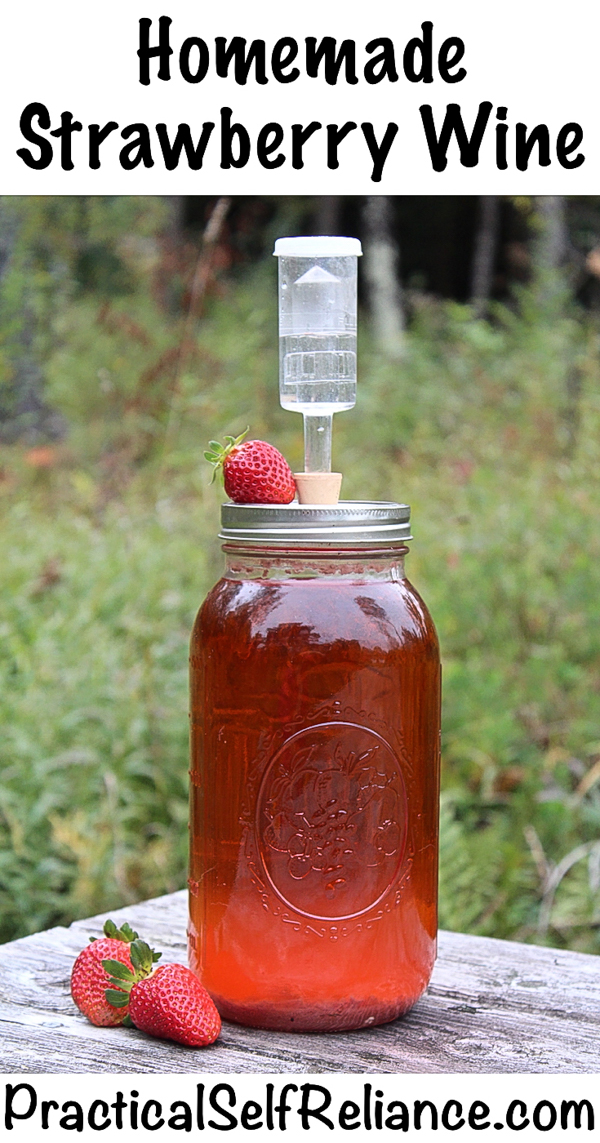


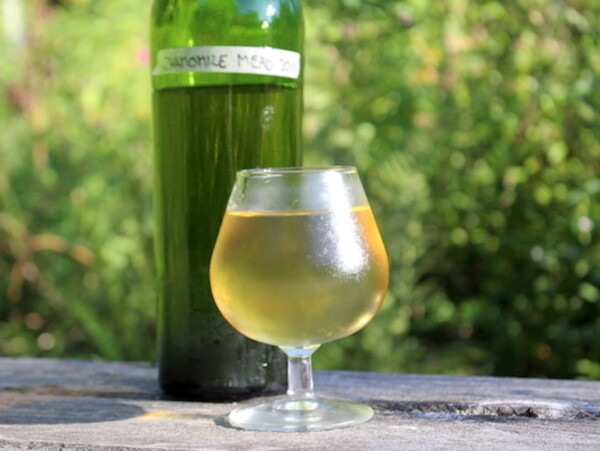
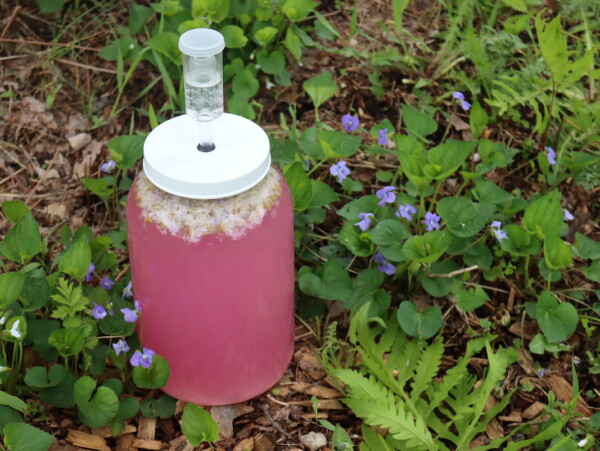










Greeting from Greece. Your recipe looks great. Just a quick question please. You mention 1 wine yeast. How many grams or oz. is that? I find it in bulk here. Thank you in advance.
Oh that’s interesting, it always comes in tiny packets here, but you have much more of a winemaking culture there, it makes sense it’d be available in bulk. In the US, wine yeast comes in 5 gram packets, regardless of the type. I’ll have to start including that info in my recipes! Thanks.
I’d like to make a version of this wine as naturally as possible — ideally without using acid blend, tannin powder, or pectic enzyme. Do you have any natural or low-intervention alternatives you’d recommend instead?
That is a really great question! I just went back in and updated the article with substitutions you can find in your kitchen. I have an article on winemaking ingredients that describes the reasoning for each ingredient if you’re intere in why they’re in here: https://practicalselfreliance.com/winemaking-ingredients/
But here’s the quick answer:
Ingredient Substitutions
If you’d like to try to make this wine without normal pantry staples, here are a few substitutions (see the article on ingredient substitutions for more details):
1 tsp Acid Blend = 1 TABLEspoon lemon juice
⅛ tsp tannin powder = 1 cup strongly brewed black tea
1 tsp yeast nutrient = ¼ cup golden raisins (sultanas)
1 tsp pectic enzyme = freeze the fruit for 1 week before making the wine to break down pectin
The wine yeast is tricky to substitute, don’t use bread yeast. You can hope that your sultana raisins have wild wine yeast on their skins, and it may or may not work. If you only buy one thing, I’d strongly suggest a good wine yeast for best results.
Great recipe. I subbed water with white grape juice and used champagne yeast. It’s a red headed troublemaker that’s for sure.
Nice! I hope you enjoy it!
Hi, when I did my secondary fermentation. I never noticed any bubbling in the airlock is that an issue and it also seems to be a little bit of stuff for me. I don’t know if it’s small or not. I don’t think it is I just I’m not sure so what should I do in this instant I’m probably two or three weeks from bottling them. What should I do?
The activity will significantly decrease in the second fermentation. It should be fine.
Hi is this interchangeable with any fruit? If not, what types of fruit would you use for this recipe and is this super sweet wine or the semi sweet wine?
I would say this wine is fairly sweet but it depends on your personal taste and the sweetness of the berries. If you have a fruit that you’re wanting to make into wine I would recommend searching the website. We have many different wine recipes for you to choose from.
Is there a way to bring the sweetness down without compromising the alcohol level? And I did see your other recipe I will definitely be trying I’m waiting for my ingredients to be delivered today.
If you’d like a less sweet wine, you can use a yeast that has a higher alcohol tolerance. It’ll eat more of the sugar and leave you with a dryer wine.
I tried juicing my strawberries by mashing them up a bit and adding hot water to the them and letting it sit for about 15 minutes. My strawberries turned into mush. I see you have a clear jar of juice. How did you get this? Straining thru a mesh just squeezes out some of the mush into the small bit of juice I received. How did you get so much juice out of that amount of strawberries?
I would follow the directions in the post to juice the strawberries. You can add sugar to the whole strawberries and they will naturally start to release their juice. You can then use something to muddle the berries a bit after this but there really isn’t a need to mash them completely. Once you get ready to move on to the second ferment, the “mush” or what we call the lees will settle to the bottom of the jar. When you rack the wine into the secondary fermentation vessel, you will leave that sediment in the primary fermentation vessel.
Brand new to wine making, Am trying this recipe.
Racked it today into secondary, and am just over 1/2 full.
Specific gravity is at 1.004
Should i top it off ?
Also hoping it would be a good sweet wine, can sugar water be added ?
How did your wine turn out?
Hi! Sorry if I missed this, but do you cut off the tops of the strawberries?
Yes I would remove the tops.
I have been making wine for a few years now, and most recipes ask for a bit more sugar than I would like. I do enjoy some sweetness, but not too much. How much sugar would put you between off dry and sweet?
So there are a few things you can do here. You can use a yeast with a higher alcohol tolerance, which will convert more of the sugar to alcohol and give you a dryer result, or you can cut the sugar by about 1/4 pound and see how that goes. Either way.
I would just work in small batches and decrease the sugar in the recipe until you get it to the level of sweetness that you prefer.
Tried making this and it is not as clear during the secondary as I’d like. I am only describe the color as a creamy pink ( almost exactly like Starbucks pink drink)
You could try racking it again after it has fermented some more and see if that helps.
Is it possible to heat the wine while fermenting and end the process within a few weeks rather than a few months?
I don’t mean to do this intentionally- our home doesnt have air conditioning and with the high temps in the house, I had a lot of strong fermentation on several different batches for about two or so weeks and then it all stalled out. I’d considered back sweetening or even adding more yeast to see if I could restart something but it seems to have a good alcohol content so I wondered if it just finished early.
Higher temperatures will speed up the fermenting process. If it has good alcohol content and tastes good then it should be just fine.
I usually make wine from grapes without adding any yeast, will strawberries ferment the same way without yeast as well or do i need to add it?
Wine can be made without using wine yeast. The benefit of the wine yeast is that you can control the flavor a little better. If you allow wild yeasts into your wine then you have no control over the types of yeast that are incorporated into the wine.